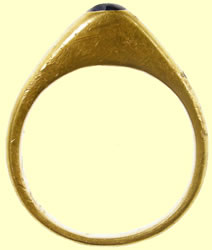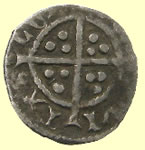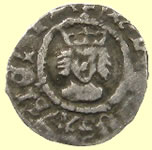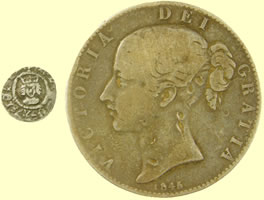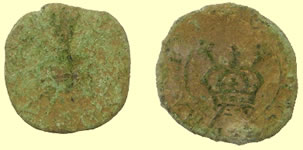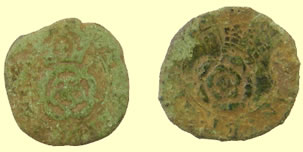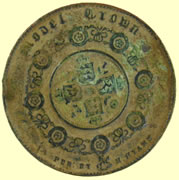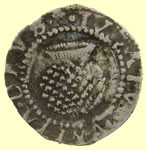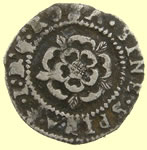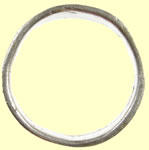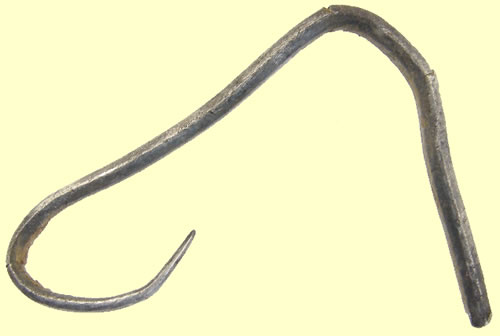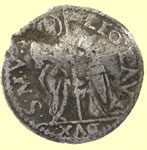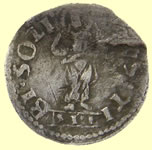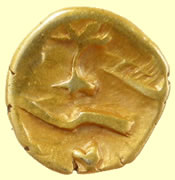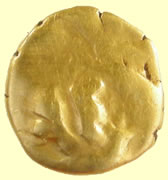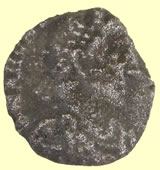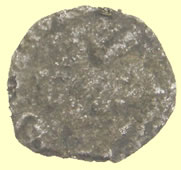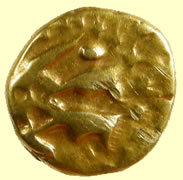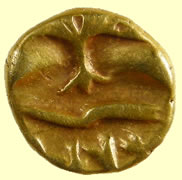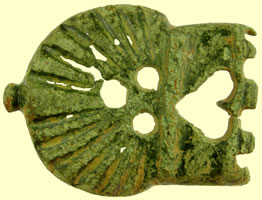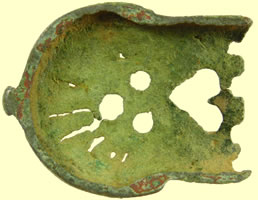

Metal detecting holidays in England with the World's most successful metal detecting club.
Twinned with Midwest Historical Research Society USA
Sept 2009 Finds Page |
Medieval gold ring with sapphire - 24.12mm dia, 11.42g - report to Colchester museum as treasure |
|||
Tiny 1485 Unrecorded Henry VII 'brushed hair' type hammered silver halfpenny - legend does match any known Henry's 10.88mm, 0.35g Obv HENRICVS A / SIE x H** Rev CIVI/TAS/LON/DON |
|||
 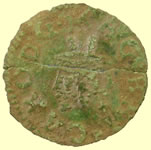 |
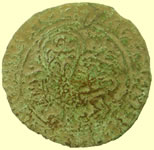 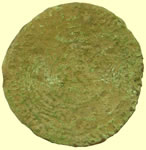 |
||
1603 James 1st hammered copper farthing |
1562 AD Hans Krauwinckel I Master German Lion of St Mark Jetton, 19.27g, 30.02mm Lion of St Mark standing left with both wings shown. Book of the Gospels between fore- paws.Halo, rising into the margin, is surrounded by a star: Obv *S*MARCVS * EVANGELLIST*GOTT*** Rev Imperial Orb surrounded by cross patty witin an ornate tressure *HANNS * KRVRENBER |
||
|
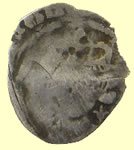 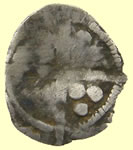 |
||
2- 1634 Charles 1st hammered coper Rose farthing - Type 2 |
1457-1476 Edward IV hammered silver penny -Bishop Lawerence Booth - Durhan mint - Lis at bust |
||
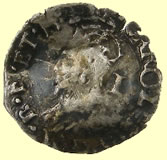 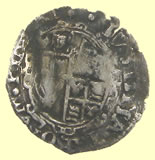 |
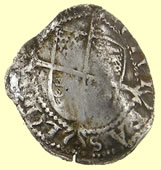 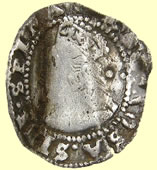 |
||
1641-3 Charles 1st hammered silver penny - mintmark 2 dots |
16thC Elizabeth 1st hammered silver half groat |
||
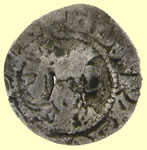 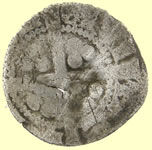 |
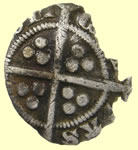 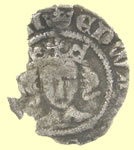 |
||
1272 Edward 1st hammered silver penny Obv EDWAR DNS ***** Rev CIVI/TAS/ ****
|
1356 Edward III hammered silver penny - Pre treaty Series F - initial mark Crown Rev CIVI/TAS/ LON/DON - London mint |
||
 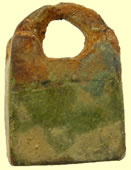 |
 |
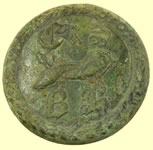 |
|
Padlock - no idea of date yet |
Georgian button |
Monogrammed button FA - B&H |
|
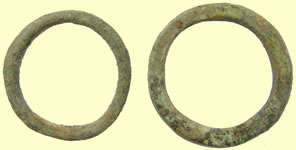 |
 |
||
Medieval harness rings |
Medieval lead pilgrims badge |
||
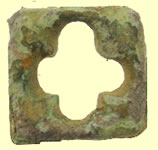 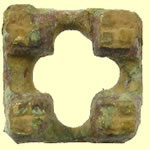 |
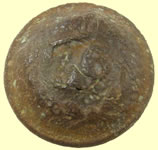 |
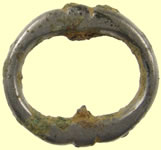 |
|
Medieval mount |
36th Regiment of foot button |
Georgian buckle |
|
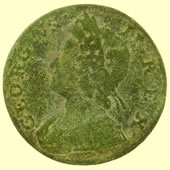  |
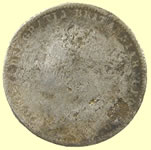  |
||
Really nice shape 1730 George II copper halfpenny |
1875 Victoria milled silver sixpence |
||
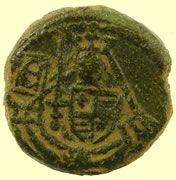 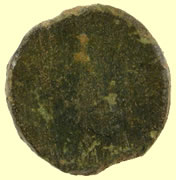 |
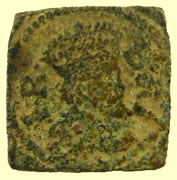 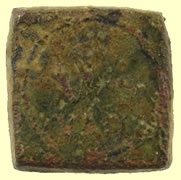 |
||
14th/15thC 1/2 Gold Ryal - King with sword and shield standing in a ship type with rose coin weight
|
1603 James 1st coin weight - Britain crown, 2nd coinage |
||
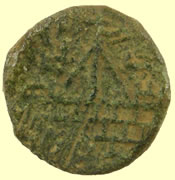 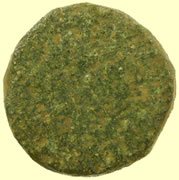 |
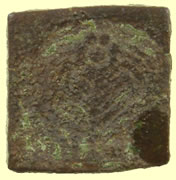 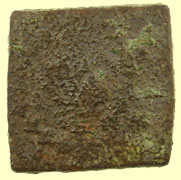 |
||
15th/16thC 'Ship with 2 lions' type coinweight for the gold noble |
1587 Rose Ryal coin weight
|
||
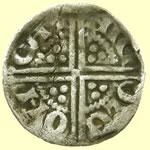 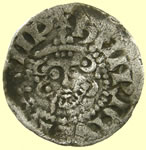 |
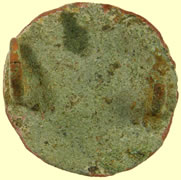 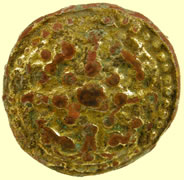 |
||
1247 Henry III hammered silver voided longcross penny - Class 2 Rev NIC(/OLE(/ON/ANT - Moneyer Nicole of Canterbury |
Unusual gilded mount with 2 integral lugs 16th/17thC |
||
 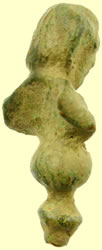 |
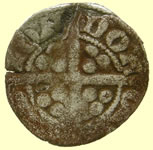 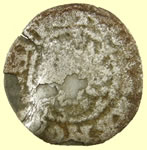 |
||
Roman bust figurine finial - 42.39mm L , 22.07g |
1272 Edward 1st hammered silver penny Obv EDWAR ANGL ****** Rev CIVI/TAS/LON/DON- London mint |
||
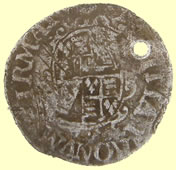 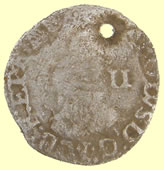 |
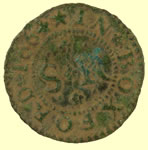 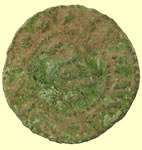 |
||
1634 Charles 1st hammered silver half groat( 2 pence) |
Excellent find, new one to us - 1664 Susannah King of Boxford, Suffolk, hammered copper trade farthing |
||
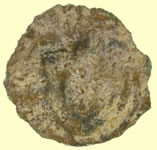  |
 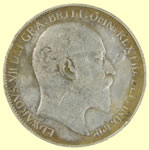 |
||
Medieval shield jetton |
1910 Edward VII milled silver sixpence |
||
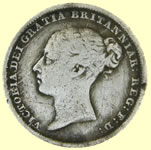 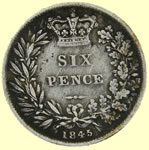 |
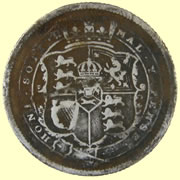 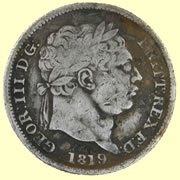 |
||
1845 Victoria milled silver sixpence |
1819 George III milled silver shilling (12 pence) |
||
Victorian model crown coin mdcccxlviii (=1848) |
|||
Joseph Moore was a noted Birmingham medallist (1817 - 1892) who trained under Halliday. He was then in partnership as Allen & Moore (1840 - 1858) and the A&M initials are on many pieces of this period. From 1859 onwards he was trading in his own name with the Moore business eventually being acquired by Fattorini & Sons in 1920. In 1844 Moore produced models (patterns) of a bimetallic penny as a suggestion for a change in the currency of the realm by using lighter and smaller coins than the much heavier and larger "cartwheels" then still in general use. Later, in 1847 / 1848 Moore's firm produced a range of model pieces ranging from 1/16th of a farthing (6mm diameter) through to the bimetallic half pennies and pennies and up to the very ornate crowns, also bimetallic, and quarter sovereigns. The lower denominations were very small and not actual currency in force in the UK either at that time, or before or since. The smaller pieces were probably produced to enhance his own expertise and to market the larger pieces and they have readily become collectable today as "Model Coins". The bimetallic pennies - still seen in abundance today - were so popular with the general public that the Royal Mint had to make an official announcement that they were not legal tender. Moore meant them to be serious models for consideration as currency and most have "Model" on them which probably saved Moore from prosecution under the Counterfeit Laws. |
|||
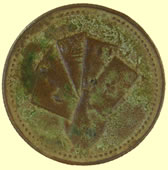 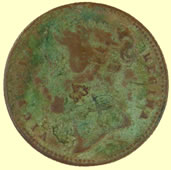 |
 |
||
Victorian gaming token |
Medieval decorated book clasp |
||
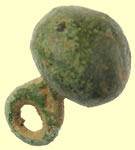 |
 |
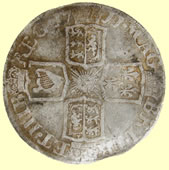  |
|
16thC Tudor button |
Victorian silver bottle stopper |
1711 Anne milled silver sixpence |
|
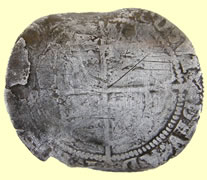 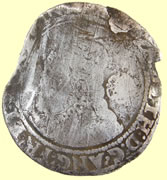 |
 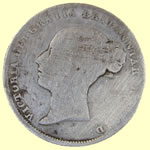 |
||
16thC Elizabeth 1st hammered silver sixpence |
19thC Victorian milled silver sixpence |
||
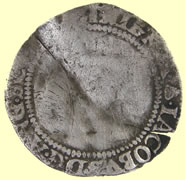 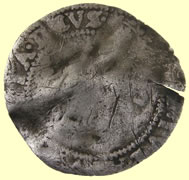 |
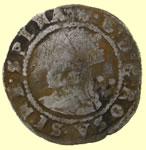 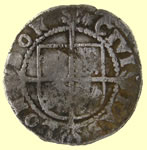 |
||
1603 James 1st hammered silver sixpence |
1573-8 Elizabeth 1st hammered silver half groat |
||
 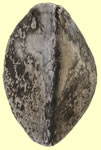 |
 |
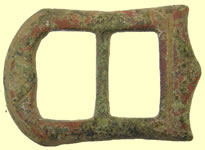 |
|
Post medieval hammered silver half groat |
Georgian spur buckle |
1575-1700 buckle |
|
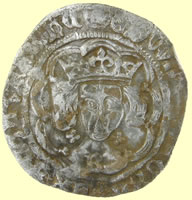 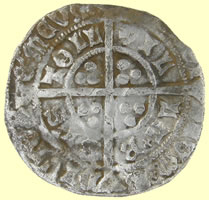 |
|||
1466/7 Edward IV hammered silver groat - Bristol (B on breast) Quatrefoils by bust - Crown inital mark Obv EDWARD DI GRA REX ANGL Z FRANC Rev VIL/LA+B/BIS/TOLL 25.6mm,2.88g |
|||
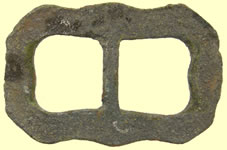 |
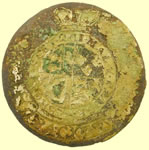 |
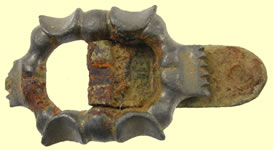 |
|
1600-1720 buckle |
One piece Navy button HONI SOIT QUI MAN Y PENSE PACKET Honi soit qui mal y pense (Old French: shame upon him who thinks evil of it) RN - Packet Service c.1800-1811 |
1600-1720 buckle |
|
 |
 |
||
Medieval decorated book clasp |
15thC open topped thimble |
||
 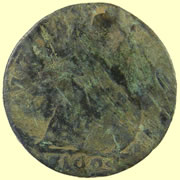 |
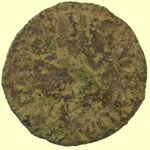 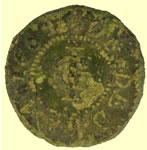 |
||
1694 William and Mary copper half penny |
1664 Joseph Gleson of Dedham Copper trade farthing
|
||
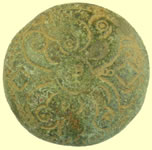 |
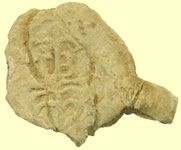 |
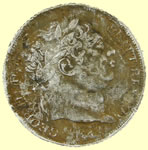  |
|
17thC button |
Post medieval lead bale seal |
1816 George III milled silver sixpence |
|
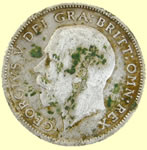  |
 |
||
1924 George V milled silver sixpence |
18thC musket trigger guard |
||
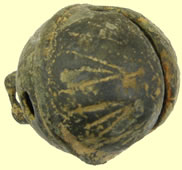 |
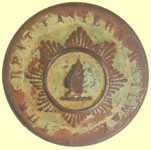 |
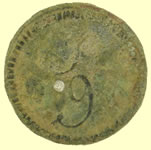 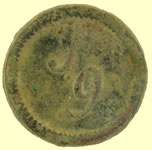 |
|
16thC crotal bell |
Great Eastern railway button |
1770's 9 shilling coin weight |
|
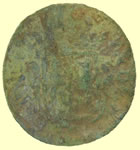  |
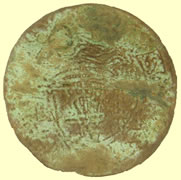 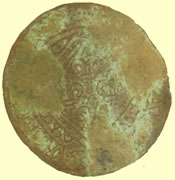 |
||
18thC Dutch copper coin |
1553 Hans Schultes I 'Ship penny' jetton Obv Sailing ship facing left Rev Traditional 'four fleurs in a lozenge' crown HANS rosette SCHVLTES cross PO |
||
  |
 |
 |
|
17thC mount with 2 integral lugs |
Medieval lead papel badge fragment |
15thC casket key |
|
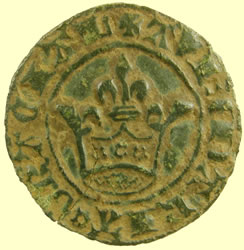 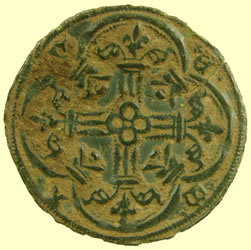 |
|||
Mint condition 1340 AD French Jetton Crown introduced in 1340 by Philip VI (1328-50) Royal Crown with 3 rosettes across body of crown Rev Triple banded straight cross fleuretty AV |
|||
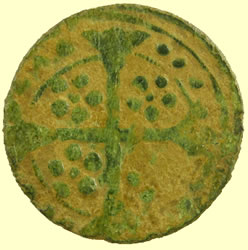 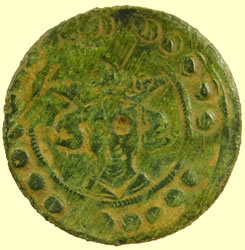 |
|||
1310-14 Sterling bust English Jetton Edward II Class XI Rev - Long cross patonce 6 pellet clusters in angles, border pellets Obv - Bust Class II in circle, border pellets |
|||
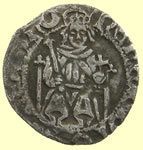 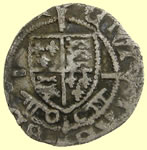 |
|
||
1485 Henry VII hammered silver sovereign penny - Keys by shield - Archbishop Rotherham - no pillars to throne York mint |
1609 James 1st hammered silver half goat |
||
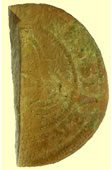 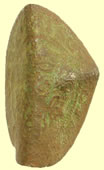 |
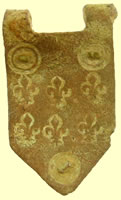 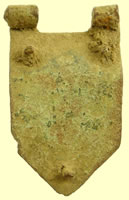 |
||
1586 Hans Krauwincel II Rose orb Jeton HANNS KRAVWINCKEL IN NVRENB |
Beautiful decorated medieval buckle chape - Fleur de lis design and 3 rivet fixing |
||
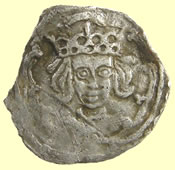 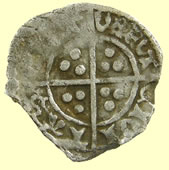 |
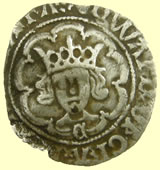 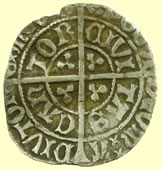 |
||
This coin has me stumped at the moment, clearly a clipped half groat by the double inner ring on obv. CIVI/TAS type but with a mint legend I do not know VERUT ?. Bust has mad eyes but with an unusual hair style. Crown is also very unusual. Facinating coin - Ricahard III ? |
1471 Edward IV hammered silver half groat - C on breast XVIII/XX Rose initial mark Obv EDWARD DI GRA REX ANGL Z FRA Rev CIVI/TAS/CAN/TOR - Canterbury mint 19mm, 1.18g |
||
 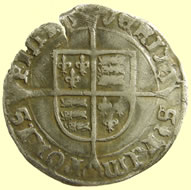 |
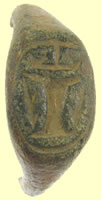 |
||
1553 Mary hammered silver groat 1.98g, 24.26mm |
Medieval seal ring
Edward Saddler |
||
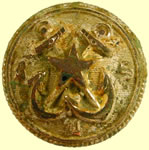 |
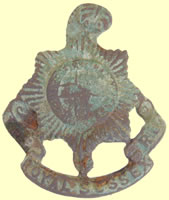 |
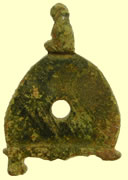 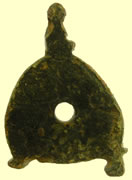 |
|
? |
Royal Sussex regiment cap badge |
Medieval strap and hanger fitting |
|
  |
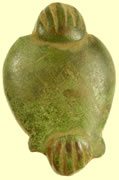 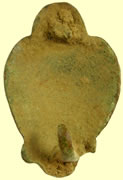 |
||
1912 silver badge - Birmingham hallmark |
17thC mount with 2 integral lugs
|
||
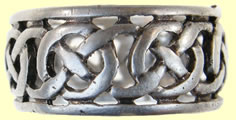 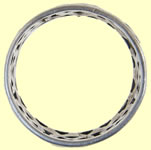 |
|||
Heart attack find - Celtic style silver ring hall marked 925 silver |
|||
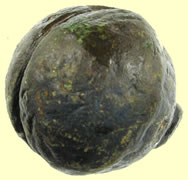 |
 |
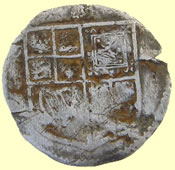 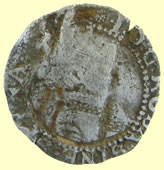 |
|
17thC decorated crotal bell |
17thC bell donger |
1606/ 7 James 1st hammered silver half groat -escallop mint mark |
|
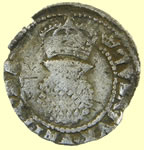 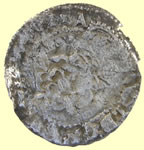 |
 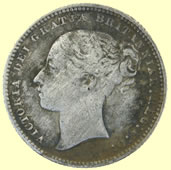 |
||
1607-9 James 1st hammered silver penny -Coronet mint mark |
1871 Victorian milled silver shilling |
||
Sterling silver finger ring |
|||
|
|
|||||||||||
Medieval silver decorated bodkin needle - reported to museum as treasure |
|||||||||||
 |
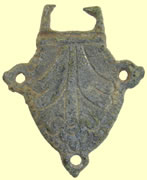 |
 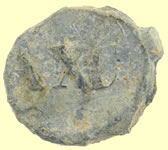 |
|||||||||
Army cap badge |
17thC clothing fastener |
Post medieval bale seal |
|||||||||
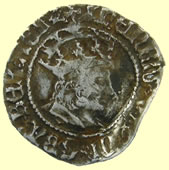 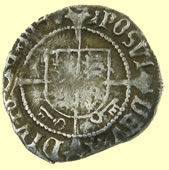 |
 |
 |
|||||||||
|
1508-14 Henry VIII hammered silver halfgroat - Marlett mint mark Archbishop Brainbridge issue - keys below shield
|
Arabic lettering on an enamelled badge ?? |
Military button ? |
|||||||||
  |
  |
||||||||||
Not sure yet - possible sissor handle |
1272 Edward 1st hammered silver penny, Class 2a Obv EDWR ANGL *** Rev CIVI/TAS ** |
||||||||||
 |
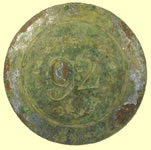 |
|
|||||||||
Medieval pot leg |
|
Medieval purse bar arm - decorated, some blue enamelling remaining |
|||||||||
 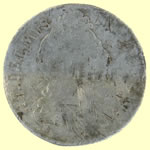 |
  |
||||||||||
1697 William III milled silver sixpence |
1247 Henry III hammered silver short cross cut half penny Obv HENRIC *** |
||||||||||
 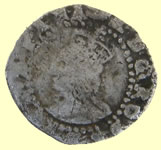 |
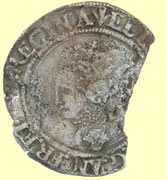 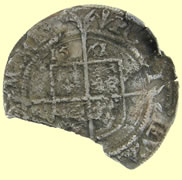 |
||||||||||
1594-6 Elizabeth 1st hammered silver penny |
1561 Elizabeth 1st hammered silver 6 pence |
||||||||||
 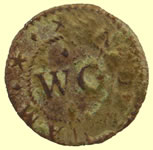 |
  |
||||||||||
17thC William Greeveson of Durham hammered copper trade farthing |
Roman baldric mount |
||||||||||
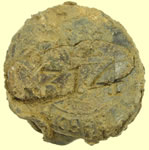 |
 |
 |
|||||||||
Post medieval lead bale seal |
19thC livery button |
||||||||||
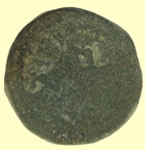 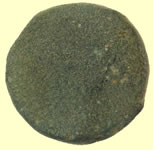 |
 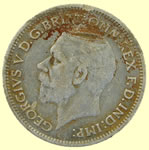 |
||||||||||
Hnery VIII coin weight - Crown H |
1935 George V milled silver sixpence |
||||||||||
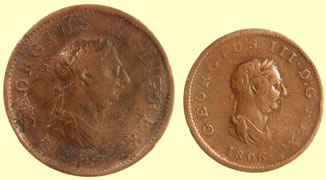 |
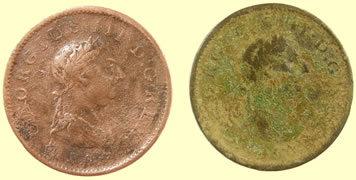 |
||||||||||
Lemon juice method used to clean up 1808 George III penny and half penny |
|||||||||||
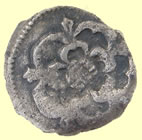 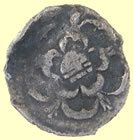 |
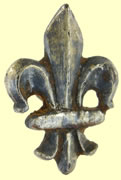  |
||||||||||
Probably one of the smallest hammered silver coins you can find, 1/3rd the weight of a Medieval silver farthing 1625-42 Charles 1st hammered silver half penny - Rose each side - no legend type
0.17g, 9.5mm |
Medieval silver Fleur De Lis hat badge - reported as treasure to museum |
||||||||||
1501-1521). Rev: LAVS TIBI SOLI (Thee Alone be Praised). Haloed figure of Christ holding a cross. Obv: LE LAV DVX S M V (Leonardo Lauredan, Doge. St Mark of Venice.) Doge kneeling before Saint Mark. |
|||||||||||
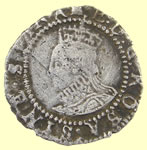 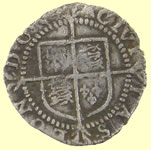 |
 |
||||||||||
1582-3 Elizabeth 1st hammered silver penny - Bell mint mark |
Large medieval lead weight |
||||||||||
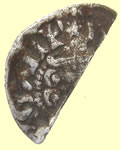  |
 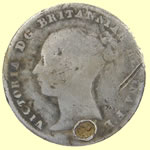 |
||||||||||
1247 Henry III hammered silver voided long cross cut half penny |
1861 Victorian milled silver 3 pence |
||||||||||
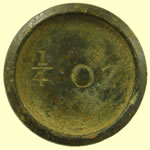 |
 |
 |
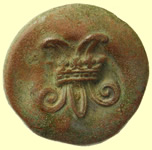 |
||||||||
Victorian 1/4 oz trade weight |
WWII Air training corp |
WWII Royal air force |
WWII Woman's land Army button |
||||||||
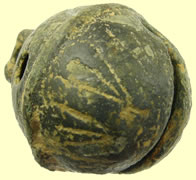 |
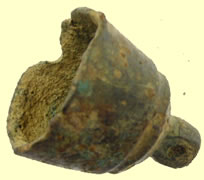 |
  |
|||||||||
17thC decorated crotal bell |
Georgian horse harness bell |
17thC mount with 2 integral lugs |
|||||||||
  |
 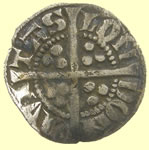 |
||||||||||
1816 George III milled silver sixpence |
1279 -Edward 1st hammered silver penny - Cross Potent Class 3f - Lombardic N Obv EDWR ANGL DNS HYB Rev CIVI/TAS/LON/DON - London mint 1.18g, 18.71mm
|
||||||||||
 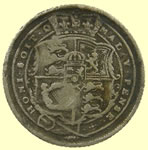 |
 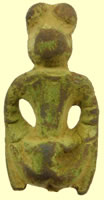 |
||||||||||
1817 George III milled silver sixpence |
Medieval figurine mount 32.86mm H , 10.30g |
||||||||||
 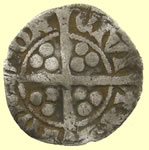 |
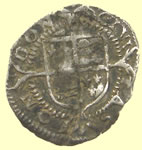 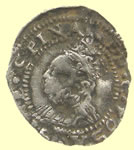 |
||||||||||
1341 Edward III hammered silver florin penny Obv EDWR ANGL DNS HYB Rev CIVI/TAS/CAN/TOR- Canterbury mint 17.11mm, 1.13g |
1560-1 Elizabeth 1st hammered silver penny - Martlet mint mark - 2nd issue 14.68mm, 0.51g |
||||||||||
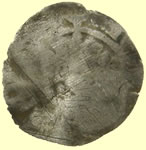 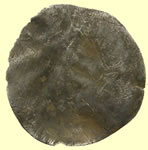 |
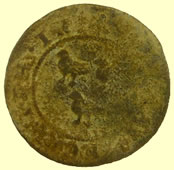 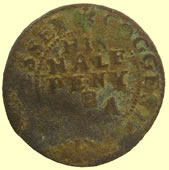 |
||||||||||
Medieval Edward long cross hammered silver penny |
17thC Thomas Beckwith of Coggeshall in Essex hammered copper trade half penny |
||||||||||
 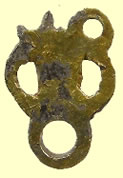 |
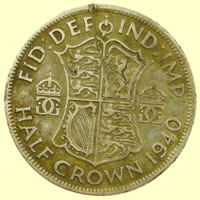  |
||||||||||
16thC Tudor jewelry clasp - gold on silver - reported to museum as treasure 13.01mm H, 0.80g |
1940 George VI milled silver half crown (30 pence) |
||||||||||
  |
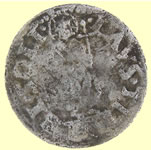 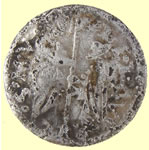 |
||||||||||
1553 Mary hammered silver groat |
1501-1521). Rev: LAVS TIBI SOLI (Thee Alone be Praised). Haloed figure of Christ holding a cross. Obv: LE LAV DVX S M V (Leonardo Lauredan, Doge. St Mark of Venice.) Doge kneeling before Saint Mark. |
||||||||||
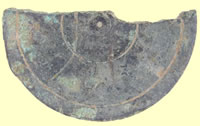 |
 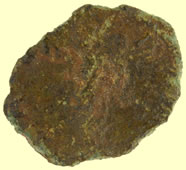 |
||||||||||
Huge 15th/16th C Henry VIII trade weight |
Mid 4thC Roman coin - Barbarius Rdiate type |
||||||||||
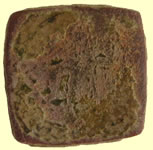 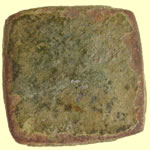 |
|||||||||||
Medieval gold noble coinweight |
|
||||||||||
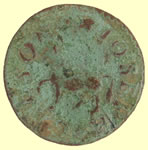 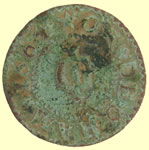 |
 |
 |
|||||||||
1664 Joseph Gleson of Dedham Copper trade farthing
|
Great Eastern railway button |
Generic Merchant Navy button |
|||||||||
 |
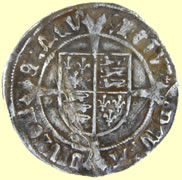 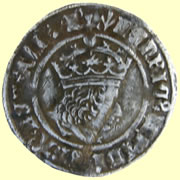 |
||||||||||
16thC crotal bell |
1509 -26 Henry VIII hammered silver groat - Pheon mint mark 2.87g, 26.93mm |
||||||||||
70BC Morini 'boat tree' type Celtic gold 1/4 stater 1.46g, 11.33 mm |
|||||||||||
Tiny Mid 4thC Roman silver coin - clipped to appear like a Saxon sceat 13.2mm,0.70g The siliquae of the late 4th and early 5th century were quite small and rather lightweight - it tends to show, among other things, how little silver the Romans had easy access to at that point. Your piece may be a fractional siliqua struck with full-size siliqua dies, a contemporary copy, or may have deteriorated in situ - or there may be yet another story behind this one. There was a time in the post-Roman era when existing siliquae were officially clipped down to a size and weight to circulate alongside Saxon sceatta - and this may be a product of that or a similar era and process.
I will look forward to seeing whatever may come of your cleaning efforts, since there's not enough showing to tell you anything you don't already seem to know about this one.
Mark
|
|||||||||||
70BC Morini 'boat tree' type Celtic gold 1/4 stater 1.48g, 10.28 mm |
|||||||||||
Mark Lehman has sent me futher information on Fl Don's Roman silver find
Under closer examination and tweaking the images a little, I'm pretty sure this piece at least began its career as a half-siliqua of Arcadius, 383-408 AD. If I am reading the lower letter-seriphs on the obverse correctly, what's visible should, I believe, read "D N ARCADI [ VS P F AVG]" - the legend breaking between I - V is correct for Arcadius too.
Interestingly - and I'm not sure whether this "proves" anything or not, I also have a siliqua of Arcadius showing some clipping and which also weighs exactly 0.7gm http://www.stoa.org/gallery/album83/02_Arcadius_Sil_MIL - this complicates the issue a little, since I can't see any features on the reverse of your coin which would indicate either Roma seated left (legend: VIRTVS ROMANORVM or VRBS ROMA) or a "Vota" type with vows: VOT / X / MVLT / XX in a wreath - which are the only 2 reverse types for Arcadius' siliquae - but that piece from my collection might also be a siliqua officially clipped-down to sceat-size. Certainly to make a sceat out of a half-siliqua would require the removal of a lot less metal - or your piece might merely be a skimpy, underweight half-siliqua with no clipping.
However, the reverse of yours I cannot be quite as certain about as the obverse, but I believe it is VICTORIA AVGG (or AVGGG, depending on the era - 2 emperors before, or 3 after the ascension of Theodosius II in 402) with Victory advancing left holding wreath and palm. I believe I can see [VI] CTOR [IA AVGG(G?)] between 9:00 - 11:00. The crook-like feature at the top-right should be Victory's arm holding up a wreath at about 12:00. Although these are AE denominations and some years earlier, the general design of the reverse should be the same or similar as one or the other of these two: http://www.stoa.org/gallery/album82/09_Valentinian_I_SER_ALE or http://www.stoa.org/gallery/album82/37_Valentinian_II_VIA_SIS
I can't make out anything at all for a mint mark, so I can't tell you the city of origin with certainty, but it appears that Arcadius struck half-siliquae only at Milan (MD in exergue) Aquilea (AQPS in exergue) or Rome (RM in exergue). In case you can make out letters at the bottom, that's the list of probable exergual mint marks to look for on a half-siliqua of Arcadius.
Good digging this season!
It's encouraging that your first Roman is an interesting AR instead of an AE grot for a change!
Mark |
|||||||||||
Medieval dagger chape |
|||||||||||
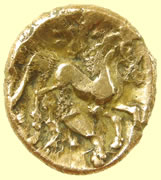 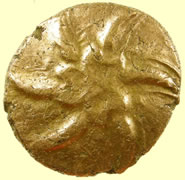 |
|||||||||||
45 BC Addedomaros Celtic gold coin 18.64mm, 5.61g sent to CCI for recording Very unusual die strike - gold appears to be in an almost non moldern state during the strike |
|||||||||||
 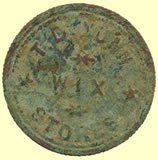 |
  |
||||||||||
T.D Nunn Wix store half sovereign token (126 pence) |
1845 Victorian milled silver sixpence |
||||||||||
 |
  |
||||||||||
Watch winders |
Neat Find - lead toy soldier |
||||||||||
 |
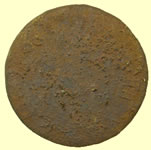 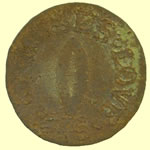 |
||||||||||
Georgian Harness shield mount with initials GG |
19thC Token - Lowe |
||||||||||
 |
 |
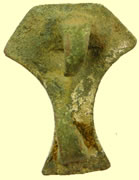 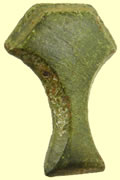 |
|||||||||
Military badge ? |
18thC clog fastener |
17thC mount with 2 integral lugs |
|||||||||
 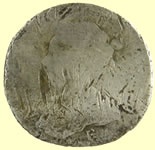 |
 |
||||||||||
1704 Queen Anne sixpence |
16thC Tudor S belt clasp |
||||||||||
 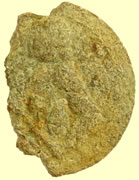 |
|
||||||||||
Admiral Edward Boscawen at the battle of Porto Bello 1737,37.27mm dia |
Saxon Stirrup terminal Early Medieval 11th century |
||||||||||
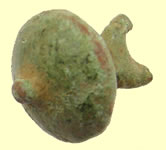 |
|
  |
|||||||||
16/17thC Tudor button |
Roman harness loop junction - 2 rivet fixing |
1634 Charles 1st hammered copper rose farthing |
|||||||||
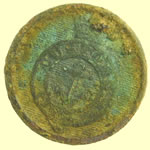 |
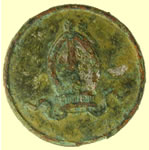 |
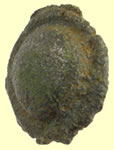 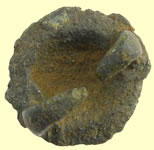 |
|||||||||
Royal navy customs button |
19thC Livery button with bishops mitre |
17thC mount with 2 integral lugs |
|||||||||
 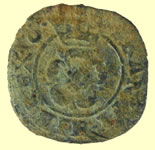 |
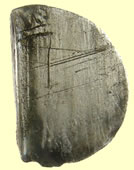 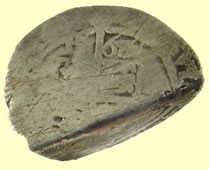 |
||||||||||
1634 Charles 1st hammered copper rose farthing |
1563 Elizabeth 1st hammered silver six pence |
||||||||||
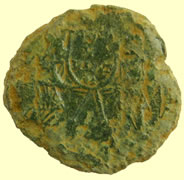 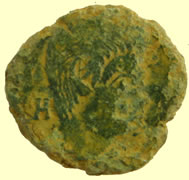 |
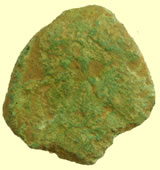 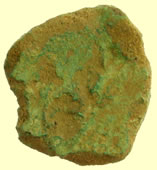 |
||||||||||
Interesting Roman bronze coin sent off for ID (non hoard) This is another of the Magnentius/Decentius centenionales.
You can only tell them apart by the obverse legends, so I can't say which one of them this is on the basis of these photos, but it's the common VICTORIAE DD NN AVG ET CAES, 2 Victories reverse they both used.
Mark
|
4thC Roman bronze coin in poor shape |
||||||||||
  |
 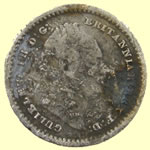 |
||||||||||
1603 James 1st hammered silver sixpence |
William IV milled silver 1 1/2 pence |
||||||||||
 |
|||||||||||
